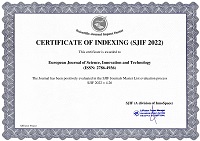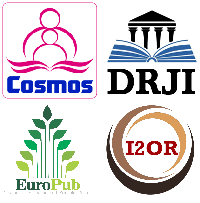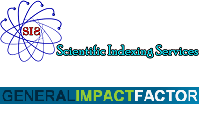Optimum Polyethylene Glycol Level Suitable for Inducing Water Stress in Potato (Solanum tuberosum L.) Genotypes in Kenya
Abstract
Water stress is a critical abiotic constraint that reduces crop productivity by preventing the expression of the genetic potential. Breeding programs prioritise developing climate smart resilient potato cultivars, that are pathogen-resistant, high-yielding and commercially viable. Modern biotechnological approaches, including in vitro drought stress screening using polyethylene glycol (PEG) 6000, have enhanced efficiency in identifying tolerant genotypes. PEG uniformly reduces water potential, mimicking soil moisture deficits. This study determined the optimal PEG level for inducing water stress in selected potato genotypes including; CIP390478.9, CIP397077.16, CIP392797.22, CIP398190.735, and local varieties Unica as tolerant and Shangi as sensitive checks. A randomized complete block design (RCBD) with five PEG levels (0.0–0.04 gL⁻¹) was replicated thrice, conducted at ADC Molo Tissue Culture Laboratory. Significant differences (P<0.05) in performance were observed among genotypes and PEG levels. Morphological parameters were highest at 0.02 gL⁻¹ PEG, with CIP392797.22 exhibiting superior tolerance, followed by CIP398190.735. Shoot and root development declined at higher PEG levels (0.03 - 0.04 gL⁻¹). These finding underscored the use of PEG in screening drought-tolerant genotypes for other areas in Kenya.
References
Anithakumari, A. M., Nataraja, N., Visser, G. F. R., & Var der Landen, G. C. (2012). Genetic dissection of drought tolerance and recovery potential by quantitative trait locus mapping of a diploid potato population. Molecular Breeding, 30, 1413-1429.
CIP International Potato Centre. (2018). CIP releases new edition catalogue of Potato Varieties. http//www.cipotato.org/catalogue. Edited December 5th 2012.
Ebrahim, M.K.H., Ibrahim, I.A., Emara, H.A., & Komor, E. (2006). Impact of polyethylene glycol – induced water stress on growth and development of shoot tip cultures from different banana (Musa spp.) cultivars. Journal of applied Horticulture, 8(1), 53-57.
FAO. (2020). FAOSTAT Database. World Food and Agriculture – Statistical Yearbook 2020. http://faostat.fao.org/
Githinji, G. G., Kinyua, M., Kiplagat, O. & Birithia, R. (2016). Evaluation of drought tolerance in mutant Kenyan bread wheat (Triticum aestivum L.) using in vitro techniques International Journal of Agronomy and Agricultural Research (IJAAR), 9(2), 180-189.
Hamza, K. A., Abd El-Aziz, M.H., Behiry, S. H. & Younes, H. A. (2018). Isolation and purification of Potato virus Y isolate infecting potato (Solanum tuberosum L.) in Al-Nubaria region. Middle East Journal of Agriculture Research, 7, 1201-1207.
Hassan, P. D. (2009). In vitro and in-vivo screening of potato cultivars against water stress by Polyethylene Glycol and Potasium Humate. Biotechnology, 8(1), 132-137.
Kylyshbayeva, G., Bishimbayeva, N., Jatayev, S., Eliby, S., & Shavrukov, Y. (2025). Polyethylene Glycol (PEG) Application Triggers Plant Dehydration but Does Not Accurately Simulate Drought. Plants, 14, 92. https://doi.org/10.3390/ plants14010092
Kooyers, J. N. (2015). The evolution of drought escape and avoidance in natural herbaceous. Plant Science Journal, 234, 155-162. https://doi.org/10.1016/j.plantsci.2015.02.012
Mahmood, M., Bidabadi, S., Ghobadi, C. & Gray D. J. (2012). Effect of methyl jasmonate treatments on alleviation of polyethylene glycol -mediated water stress in banana (Musa acuminata cv. ‘Berangan’, AAA) shoot tip cultures. Plant Growth Regulation Journal, 68, 161–169.
Maina, M., Gathumbi, M., Onchienku, P., Nganga, N., Kagundu, A., Kibet, S., Muchoki, J. & Borus, D. (2016). The National Potato Strategy (2016 - 2020). Ministry of Agriculture Livestock and Fisheries.
Mihaela, A. C., Tican, A. M., Maria, I. & Badarau, C. L. (2016). The growth response of several potato genotypes (Solanum tuberosum L.) induced water stress using sorbitol and polyethle glycol (PEG). Biological Science, 8(4), 511-519.
Mir, R. R., Zamman-allah, M., Sreenivasula, N., Trethowan, R. & Varshney, K. R. (2012). Integrated genomics, Physiology and breeding approaches for improving drought tolerance in crops. Theoretical Appl Genetics, 125, 625-645.
Monneveux, P., Ramirez, D. A. & Pino, M. T. (2013). Drought tolerance in potato (S. tuberosum L.) Can we learn from drought tolerance research in cereals? Plant Science, 205-206, 76 -86.
National Potato Strategy (NPS) - 2021-2025 (2025). Ministry of Agriculture, Livestock Fisheries and Cooperatives.
Obidiegwu, J. E., Bryan, G., Jones, H. G. & Prasher, A. (2015). Coping with drought: stress and adaptive responses in potato and perspectives for improvement. Frontiers in Plant Science, 6, 542. https://doi.org/10.3389/fpls.2015.00542
Puertolas, J., Ballester, C., Elphinstone, D. E. & Dodd, I. C. (2014). Two potato (Solanum tuberosum L.) varieties differ in drought tolerance due to differences in root growth at depth. Functional Plant Biology, 41, 1107-1118.
Ramirez, D. A., Rolando, J. L., Yactayo, W., Monneveux, P., Mares, V. & Quiroz R. (2015). Improving potato drought tolerance through the induction of long-term water stress memory. Plant Science, 238, 26-32.
SAS Institute (2012). Statistical Analysis System (SAS) users guide, release 8.1 1999-2000. North Carolina, U.S.A.
Sihachakr, D., Houcoour, A. J., Cavalcate, M., Umboh L., Nzoghe D., Servaes, A. & Ducreux, G. (1997). Plant regeneration of sweet potato (Ipomoea batatas L.). Euphitica journal, 96, 143-152.
Sirait, B. A. & Charloq, R. (2017). In vitro study of Potato (Solanum tuberosum L.) Tolerant to the Drought Stress. International Conference on Natural Resources and Life Sciences, 20, 188-192.
Sunaryo, W., Darnaningsih, D. & Nurhasanah, N. (2019). Selection and regeneration of purple sweet potato calli against drought stress simulated by polyethylene glycol: awaiting peer review. F1000Research, 8, 10. https://doi.org/10.12688/f1000research.16993.1
Tadesse, B., Gebeyehu, S., Kirui, L., & Maru, J. (2025). The contribution of potato to food security; income generation; employment; and the national economy of Ethiopia. International Potato Centre. 50 p. https://doi.org/10.4160/cip.2025.01.007
Copyright (c) 2025 Judith Oggema, Anthony Kibe, Maurice Oyoo, Miriam Mwangi

This work is licensed under a Creative Commons Attribution 4.0 International License.


 ISSN
ISSN 











